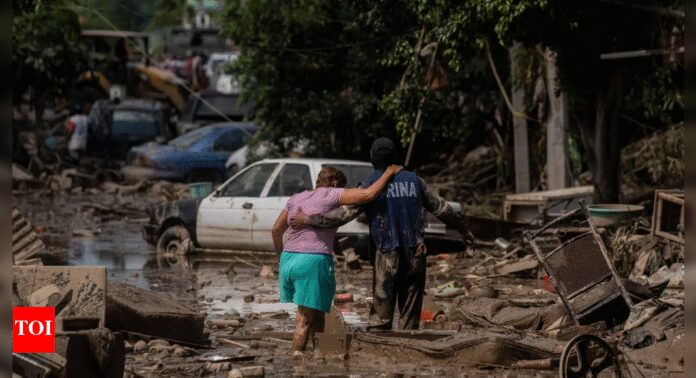TIANGUISTENGO: When a river that winds through the mountains of central Mexico suddenly turned into a crushing wall of water this week, it practically wiped the 400-person village of Chapula off the map. Residents only had time to shout, warning neighbors living along the riverbanks, and desperately seek shelter from the deadly flooding and landslides that have cut off 300 towns in central and eastern Mexico from the outside world. Thousands of soldiers and workers scrambled Tuesday to rescue civilians and unblock roads. “There’s nothing left. It wiped out houses, it wiped out the bridge, it wiped out everything. The only thing left standing was the church and the warehouse where we were seeking refuge,” said 21-year-old Stephanie Ramirez, who was part of a group of elderly, women and children who stumbled off a rescue helicopter Tuesday. The government confirmed that at least 64 people have died due to the torrential rains. Dozens are still missing and officials warn the full extent of the devastation in remote towns of a couple hundred to 1,000 residents remains unknown. The rains were triggered by the convergence of two tropical storms churning off Mexico’s western coast, striking at the end of an unusually heavy rainy season that has left rivers overflowing and hillsides weakened. Ramirez and her grandmother were evacuated after days of hoping help would come. The rest of her family and dozens of their neighbors were still waiting to be evacuated. As more rain threatened to pour down, they sought shelter on a nearby hillside on the verge of collapsing next to the still-swollen river. “We have to get them out. They’re in constant danger there,” Ramirez said. Mexican President Claudia Sheinbaum said Tuesday that one of the government’s priorities was to open roads and “to secure air bridges, food supplies, water, and check on how each person is faring.” Thousands of military and civilian personnel were working tirelessly on those efforts Tuesday, but in Chapula, residents decided to organise on their own. According to Ramirez, they called their relatives in the United States, “and it was them who made arrangements to get us out of there little-by-little.” With help from residents of the nearby town of Tianguistengo, a private air bridge began operating, using a borrowed helicopter to evacuate groups of about half a dozen people at a time, while other residents organised bags of basic goods to carry on foot, with some soldiers, to neighboring villages that were still cut off. “We think it’s about six or seven hours walking, but we want people to know that we’re working … that they can see we also care about their situation,” said local resident Neptali Rodriguez. The hardest-hit states are Veracruz, Hidalgo and Puebla. In Hidalgo alone, where roughly half of the isolated villages are located, about 100,000 homes were damaged or destroyed by flooding rivers and mudslides. In Veracruz, where at least 29 people died, rainfall reached 24 inches in just four days. Veracruz Gov. Rocio Nahle said more than 300,000 people were affected in the state alone. On Tuesday, public officials were going door-to-door in cities like Poza Rica, Veracruz, where water from the overflowing Cazones River on Friday reached 13 feet (four meters) high in some areas. They were asking residents if anyone was missing. According to the National Civil Protection Coordination, 67 people were still unaccounted for as of Tuesday. Health teams had began fumigating affected areas to prevent outbreaks of dengue, a disease spread by mosquitoes. In Poza Rica, resident Roberto Olvera said an oil refinery alarm alerted him to rising waters. “It was terrifying, many people in the neighborhood couldn’t escape,” he said. Floodwaters there also left a black, oily residue believed to have come from nearby oil and gas installations, coating trees and rooftops. Dozens of health centers were damaged, including one in Alamo, Veracruz, where floodwaters reached two meters (6.5 feet), destroying all equipment. Local health director Marti Batres said medical staff are now working outdoors. While thousands of soldiers and rescue teams search for the missing and deliver aid, helicopters are ferrying supplies to isolated zones and private construction firms are helping to reopen key roads. Sheinbaum said there are enough resources to respond and that the government “will spare no expense during this emergency.”



